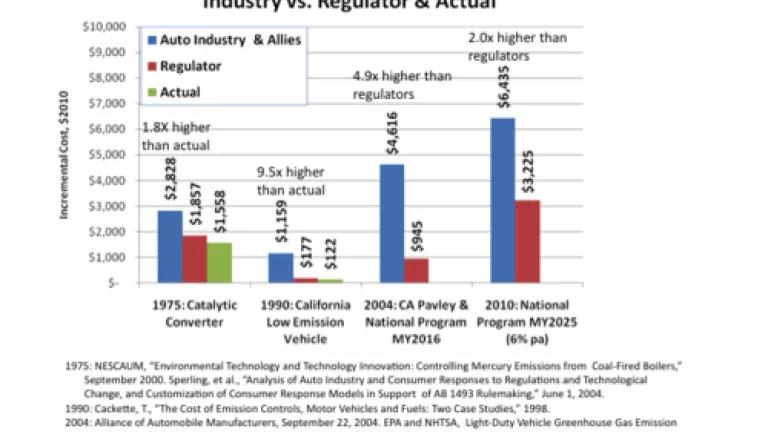
As I blogged about earlier, the Alliance of Automobile Manufacturers (AAM) recently sent letters to the new House leadership claiming the cost for meeting future fuel economy standards are twice as high as those recently estimated by three government agencies, the Environmental Protection Agency, the National Highway Traffic Safety Administration and the California Air Resources Board. This claim should come as no surprise. Over the past four decades, the auto industry has consistently exaggerated the cost for meeting new pollution standards, by as much as 9.5 times the actual costs.
A review of the latest claim reveals a simple explanation for the difference. The auto industry claim is based on a Center for Automobile Research study which relies heavily upon a National Academies of Science study of near-term 2015, not long-term 2025, fuel economy potential.
The Alliance of Automobile Manufacturers, the main lobbying organization for the auto industry, sent letters on January 11th to the new House Committee leaders, Darrell Issa (Chairman, Committee on Oversight and Government Reform) and Fred Upton (Chairman, Committee on Energy and Commerce). The letters made the identical claims that a joint analysis by the US EPA, US DOT and CARB, “systematically underestimated the costs of the proposed standards and overstate the benefits to consumers”.
Specifically, the letters state: “However, a recent Center for Automotive Research (CAR) analysis calculates fuel economy costs to be from $4,190 to $6,435 per vehicle and a lifetime fuel savings of only $1,690 to $2,693. The CAR analysis shows a 10.2% net vehicle price increase at 41.7 mpg and a 22.3% net vehicle price increase at 60.1 mpg.”
The Center for Automotive Research (CAR) is a Michigan-based research organization. Their draft analysis is currently only available as PowerPoint with only some details.
Back in 2004 when the California Air Resources Board was adopting its first round of GHG pollution standards, I created a chart that illustrated the point that the auto industry has consistently overstated the cost of complying with new pollution standards from 1.8 to as high a 9.5 times higher (I pasted it into a previous blog . This 2006 paper I co-wrote a paper on this topic--cited in Thomas Friedman’s book Hot, Flat, and Crowded --provides more details).
The auto industry’s current claim is consistent with their historic pattern of overestimation. As you can clearly see, the current estimate of $6,435 incremental cost to achieve a 6 percent per annum improvement rate is twice as high as the September 30th, 2010 estimate by the U.S. Environmental Protection Agency, U.S. Department of Transportation and the California Air Resources Board. (The costs are all in today’s (2010) dollars, using CPI inflators.)
In this case, the cause of the overestimate is simple: the CARs study relies heavily upon a recent National Academy of Sciences study that only looked at the potential for near-term fuel economy improvements. Specifically, they looked at the costs and performance of current technologies and what their impacts might be if scaled up in five years. In contrast, the agencies’ estimate is for 2025, allowing a decade or more of innovation to occur to enhance performance and reduce costs.
The NAS study states: “Tables S-1 and S-2 show the committee’s estimates of fuel consumption benefits and costs for technologies that are commercially available and can be implemented within 5 years. The cost estimates represent estimates for the current (2009/2010) time period to about 5 years in future.”
Based on their track record of consistently overestimating costs, combined with the fact the auto industry used a study of 2015 not 2025 fuel economy potential, I think it’s a fairly good bet that the estimate made by regulators is much more accurate.
